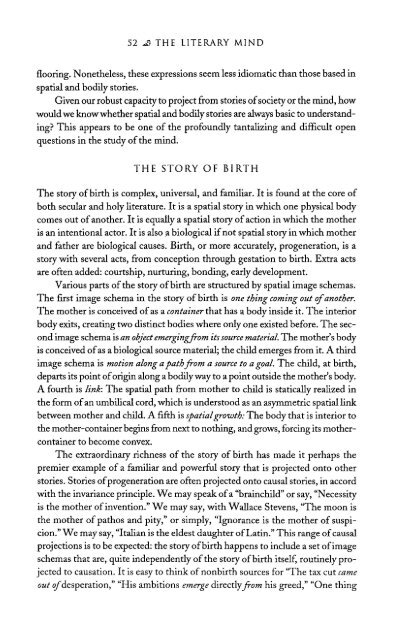The Literary Mind.pdf
The Literary Mind.pdf
The Literary Mind.pdf
Create successful ePaper yourself
Turn your PDF publications into a flip-book with our unique Google optimized e-Paper software.
52 THE LITERARY MIND<br />
flooring. Nonetheless, these expressions seem less idiomatic than those based in<br />
spatial and bodily stories.<br />
Given our robust capacity to project from stories of society or the mind, how<br />
would we know whether spatial and bodily stories are always basic to understanding?<br />
This appears to be one of the profoundly tantalizing and difficult open<br />
questions in the study of the mind.<br />
THE STORY OF BIRTH<br />
<strong>The</strong> story of birth is complex, universal, and familiar. It is found at the core of<br />
both secular and holy literature. It is a spatial story in which one physical body<br />
comes out of another. It is equally a spatial story of action in which the mother<br />
is an intentional actor. It is also a biological if not spatial story in which mother<br />
and father are biological causes. Birth, or more accurately, progeneration, is a<br />
story with several acts, from conception through gestation to birth. Extra acts<br />
are often added: courtship, nurturing, bonding, early development.<br />
Various parts of the story of birth are structured by spatial image schemas.<br />
<strong>The</strong> first image schema in the story of birth is one thing coming out of another.<br />
<strong>The</strong> mother is conceived of as a container that has a body inside it. <strong>The</strong> interior<br />
body exits, creating two distinct bodies where only one existed before. <strong>The</strong> second<br />
image schema is an object emerging from its source material. <strong>The</strong> mother's body<br />
is conceived of as a biological source material; the child emerges from it. A third<br />
image schema is motion along a path from a source to a goal. <strong>The</strong> child, at birth,<br />
departs its point of origin along a bodily way to a point outside the mother's body.<br />
A fourth is link: <strong>The</strong> spatial path from mother to child is statically realized in<br />
the form of an umbilical cord, which is understood as an asymmetric spatial link<br />
between mother and child. A fifth is spatial growth: <strong>The</strong> body that is interior to<br />
the mother-container begins from next to nothing, and grows, forcing its mothercontainer<br />
to become convex.<br />
<strong>The</strong> extraordinary richness of the story of birth has made it perhaps the<br />
premier example of a familiar and powerful story that is projected onto other<br />
stories. Stories of progeneration are often projected onto causal stories, in accord<br />
with the invariance principle. We may speak of a "brainchild" or say, "Necessity<br />
is the mother of invention." We may say, with Wallace Stevens, "<strong>The</strong> moon is<br />
the mother of pathos and pity," or simply, "Ignorance is the mother of suspicion."<br />
We may say, "Italian is the eldest daughter of Latin." This range of causal<br />
projections is to be expected: the story of birth happens to include a set of image<br />
schemas that are, quite independently of the story of birth itself, routinely projected<br />
to causation. It is easy to think of nonbirth sources for "<strong>The</strong> tax cut came<br />
out of desperation," "His ambitions emerge directly from his greed," "One thing















